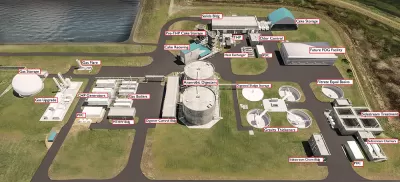A new bioenergy facility in Maryland will convert captured methane to Renewable Natural Gas.

WSSC Water, a bi-county water agency serving Prince George and Montgomery Counties in Maryland, is partnering with Montgomery County to build a bioenergy facility that will capture methane gas produced during wastewater treatment and turn it in to Renewable Natural Gas (RNG) to be used for the county’s Ride On buses.
Patrick Herron describes the Piscataway Bioenergy Facility in an article for The MoCo show, writing, “Once construction of the bioenergy facility is complete in the fall of 2024, all biosolids from WSSC Water’s five other plants will be delivered to the new facility. Through innovative technology, the amount of biosolids left over from the new treatment process will be significantly reduced and cleaner (Class A). A state-of-the-art digestion process creating these Class-A biosolids will generate methane gas, which will be captured and upgraded on site to RNG.” WSSC also plans to sell renewable energy credits.
“Construction of the $271 million facility in Accokeek, Maryland, began in the spring of 2019 and is expected to be substantially complete by November 2024.” County Executive Marc Elrich said “This agreement to turn methane gas into fuel for our buses is a win-win-win for our constituents, commuters and, most importantly, our environment.”
FULL STORY: WSSC Water and Montgomery County Partner to “Turn Poop to Power”

Trump Administration Could Effectively End Housing Voucher Program
Federal officials are eyeing major cuts to the Section 8 program that helps millions of low-income households pay rent.

Planetizen Federal Action Tracker
A weekly monitor of how Trump’s orders and actions are impacting planners and planning in America.

Ken Jennings Launches Transit Web Series
The Jeopardy champ wants you to ride public transit.

Washington Legislature Passes Rent Increase Cap
A bill that caps rent increases at 7 percent plus inflation is headed to the governor’s desk.

From Planning to Action: How LA County Is Rethinking Climate Resilience
Chief Sustainability Officer Rita Kampalath outlines the County’s shift from planning to implementation in its climate resilience efforts, emphasizing cross-departmental coordination, updated recovery strategies, and the need for flexible funding.

New Mexico Aging Department Commits to Helping Seniors Age ‘In Place’ and ‘Autonomously’ in New Draft Plan
As New Mexico’s population of seniors continues to grow, the state’s aging department is proposing expanded initiatives to help seniors maintain their autonomy while also supporting family caregivers.
Urban Design for Planners 1: Software Tools
This six-course series explores essential urban design concepts using open source software and equips planners with the tools they need to participate fully in the urban design process.
Planning for Universal Design
Learn the tools for implementing Universal Design in planning regulations.
Heyer Gruel & Associates PA
Ada County Highway District
Institute for Housing and Urban Development Studies (IHS)
City of Grandview
Harvard GSD Executive Education
Toledo-Lucas County Plan Commissions
Salt Lake City
NYU Wagner Graduate School of Public Service




























